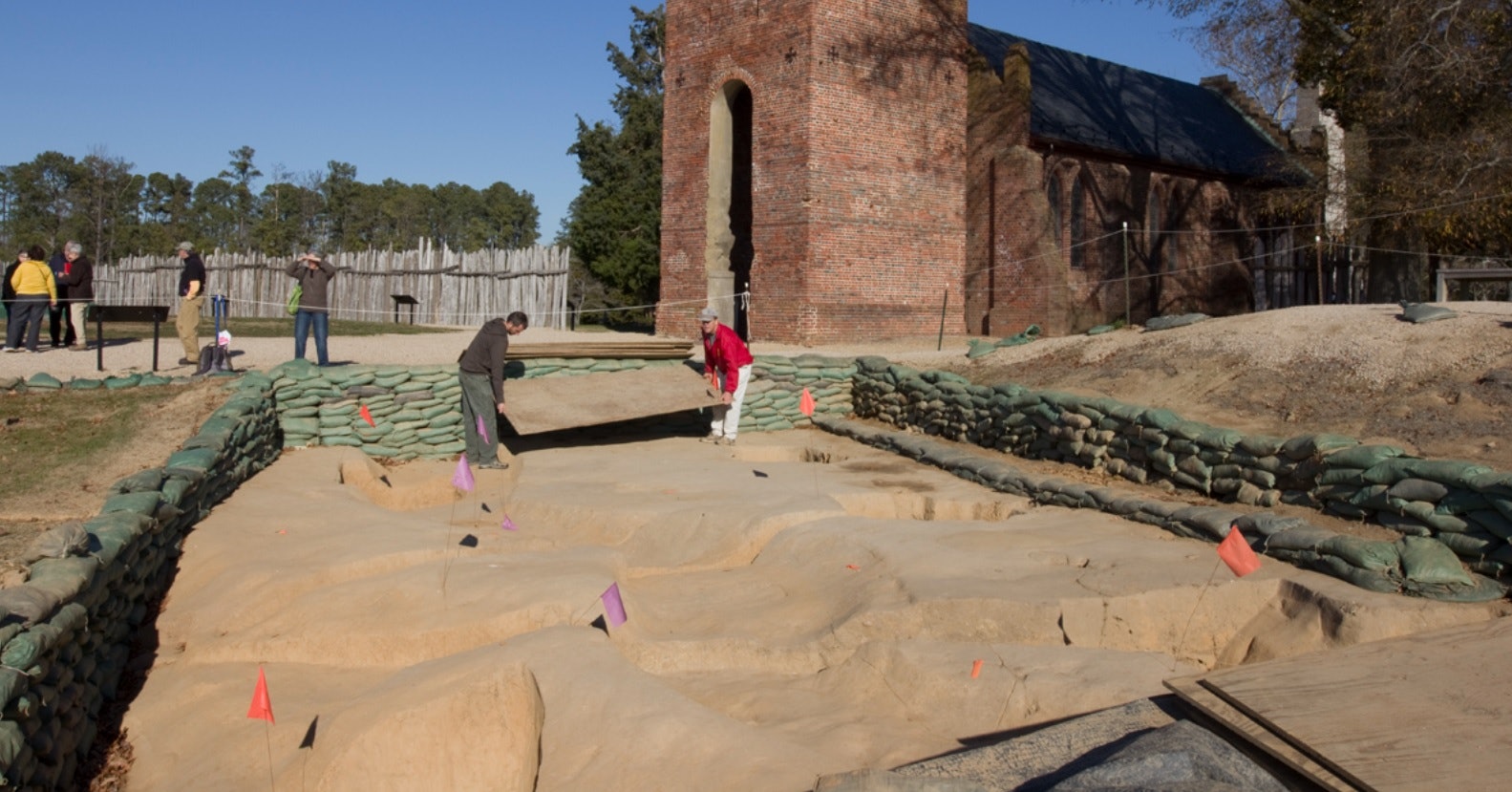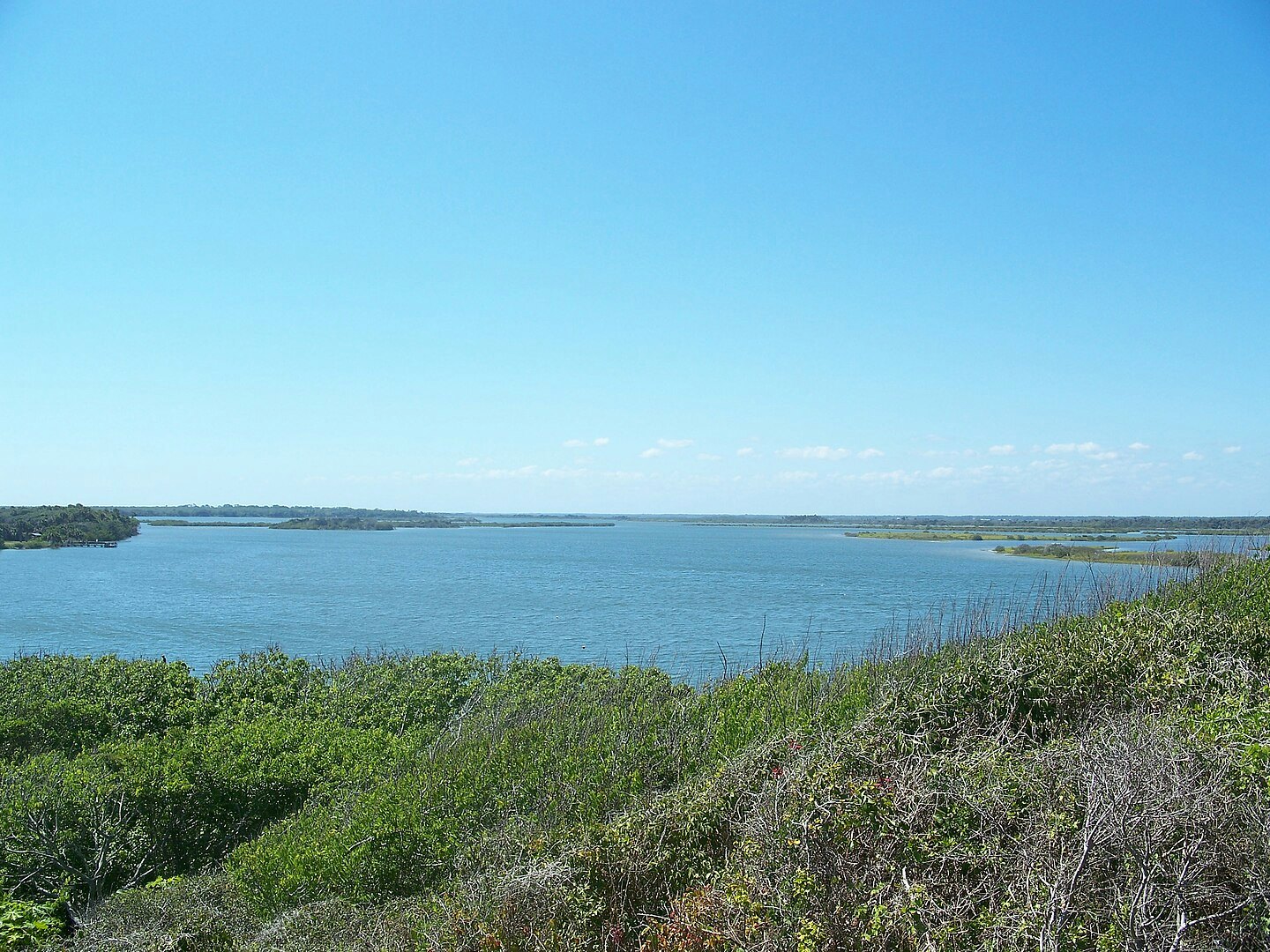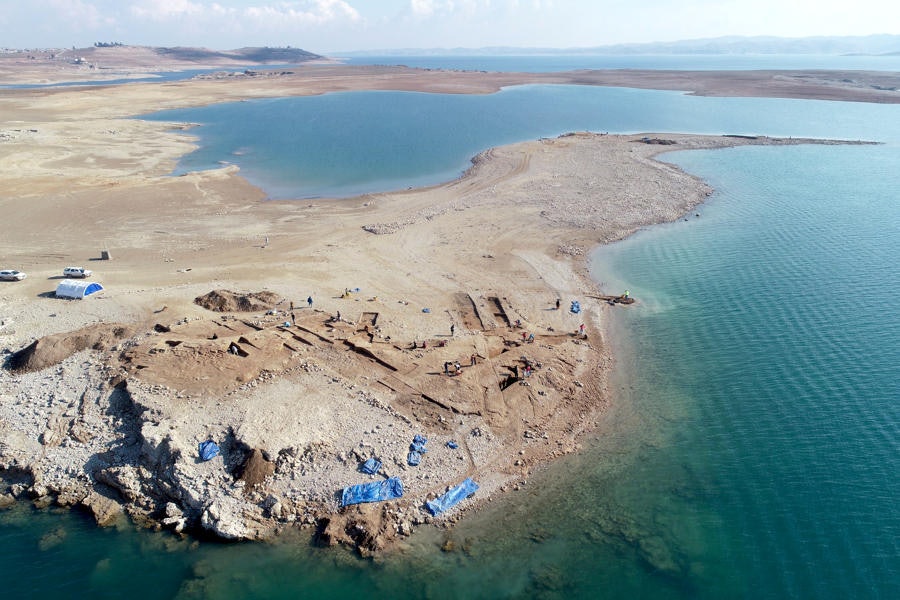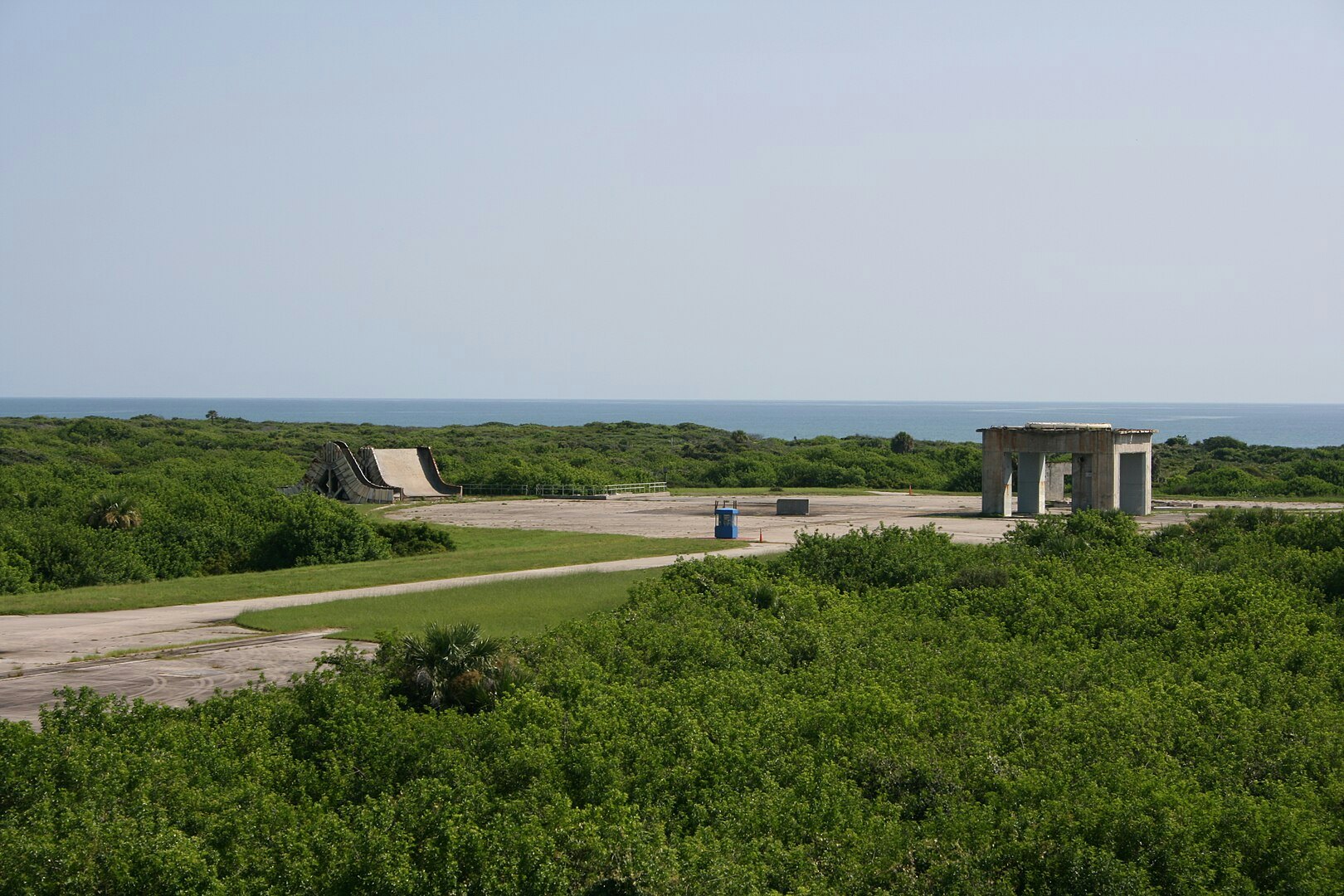
Dave Givens is preparing for battle. Sandbags pile up around what appear to be foxholes and trenches. But at the Jamestown Rediscovery site, the enemy isn’t human. It is water.
As the climate crisis deepens, water levels at the site continue to rise, putting archaeologist Givens and his crews on the front lines of an existential fight.
“We’ve been at war,” Givens tells Inverse. “We’re constantly having to fight water. We adapt and come up with ways to deal with it.”
The site is the home of the first European colonists to settle the United States. It tells a crucial story about the horrors of colonial expansion and slavery — a bloody legacy that haunts the country today. The land also holds thousands of years of Indigenous history, including clues to the earliest people to live in the region and how later Indigenous people and colonists interacted.
But what has been preserved through millennia till now is at risk of being lost as a result of the rapidly changing climate. Rising sea levels in turn raise groundwater levels beneath Jamestown, while heavy and unpredictable rainfall adds water from above. All that water has nowhere to drain. As a consequence, much of Givens’ Jamestown site is a marshland. Already, excavations at some of the outer parts of the old James Fort have been left filled with sandbags in the hope of preserving whatever may be left for the future.
“Every tidal cycle it was flooding and we were pumping out the water,” Givens recalls. “It became dangerous.”

Givens and Michael Lavin, director of collections at the site, say efforts to mitigate flooding and other climate-related damage at the site have eclipsed the work they should be doing — digging through humanity’s past.
“Our lives are now taken over with meetings and things like that about how can we save this and get Congressional support,” Lavin tells Inverse. “It’s mayhem, because it’s not just us. It’s our partners in the National Park Service. It’s the entire Tidewater of Virginia, and it’s Tangier Island out in the Chesapeake Bay where cemeteries are eroding into the water.”
Indeed, the frontier is not limited to Jamestown, or even the East Coast. Archaeological sites across the world are flooding, burning, or eroding.
Humanity is still trying to figure out what its future looks like. Meanwhile, archaeologists around the world are trying to make sure we don’t lose irreplaceable parts of our past.
The Swallowing Sea
When the last Ice Age ended sometime between 20,000 and 10,000 years ago, sea levels rose by about 120 meters over roughly 13,000 years. That equates to a little less than a meter per century, but it did irreparable damage to historic human sites. The earliest Aboriginal settlements in Australia are now submerged, and it’s likely that the first human footprints in North America are, too.
In contrast, today the oceans are rising about 20 percent faster than at the end of the last Ice Age. Current models predict that warming water and melting ice will raise the seas by a little more than a meter by 2100. For as long as humans have existed, we have tended to cluster near the coasts. As a result, our past is in grave danger.
University of Tennessee, Knoxville archaeologist David Anderson and his colleagues write in a 2017 paper that the sea rising will cause the “loss of much of the record of human habitation of the coastal margin in the southeast [U.S.] within the next one to two centuries.”
But in some areas of the world, the danger extends far beyond the coast line: Entire Pacific Island nations might soon cease to exist.

On Rapa Nui (Easter Island) in the Pacific Ocean, the famous monolithic Moai statues and the ceremonial platforms on which they stand are increasingly threatened by the rising seas. Some have already had to be moved away from the shoreline. Local people have found their ancestors’ graves eroded by the waves. Even the Moai that line clifftops or the centuries-old rock paintings that adorn caldera walls high above the water are in danger of falling into the ocean as the waves erode the rock beneath them.
And on the coast of Spain, where Neanderthals once lived in what is now known as Gorham’s Cave Complex and left behind rock engravings and traces of ancient meals, the glittering blue Mediterranean is creeping ever closer to the entrance. Another meter or so of sea level rise might flood the cave network, closing a doorway to a distant past and one of the few windows into the complex lives of our last hominin relatives.
A race against time
The island of Flores, an Indonesian island northeast of East Timor in the Pacific Ocean, is today home to about 88,000 people. But before the arrival of Homo sapiens, it was home to an enigmatic human relative known as Homo floresiensis, or Flores Man. The species had a mix of ancient and modern traits and likely stood only about three-and-a-half feet tall, earning them the nickname of “hobbits.”
Understanding the Flores Man is an important part of piecing together human history. But changing weather patterns across southeast Asia could threaten the places that may hold the answers to questions like how these tiny hominins are related to us and whether Homo Sapiens interacted with them.
On Flores, the monsoon holds sway over the island’s weather patterns. As Earth’s oceans and atmosphere warm up, scientists predict that the summer monsoon will get wetter overall but also more unpredictable, meaning there might be periods characterized by drought and others by devastating floods.

Liang Bua, the cave where University of Wollongong archaeologist Richard Roberts and his colleagues first discovered the fossil remains of H. floresiensis, is 500 meters above sea level in the mountainous interior of the island, safe from the rising sea but not from the pounding rain.
“If the monsoon becomes even stronger in the future, then at least some of the increased rainfall will likely find its way through the roof of Liang Bua and possibly erode some of the archaeological and fossil-bearing deposits,” Roberts tells Inverse.
Elsewhere on the island, other sites that may have been home to the Flores hominins and humans are closer to the coast. If those sites flood, then, over the next few decades archaeologists could lose their chance to understand our connection to the enigmatic species.
While Flores and other coastal areas struggle with the rising tides, in other places, the problem is exactly the opposite — but dry weather can also have its advantages.
Hot and dry summers across much of Europe over the last few years have revealed the ghostly outlines of Bronze Age fortresses, Roman villas, and Renaissance gardens lying just beneath the surface. Stone absorbs more heat than soil, so submerged walls might essentially bake surrounding soil and turn it a lighter hue that is easy to spot. Meanwhile, ancient ditches often hold more moisture than the packed soil around them, even (or especially) in times of drought. Taller, greener plants mark the outlines of the ditches around Iron Age burial mounds or Roman fortifications.
In these cases, it can be as if the past was drawn across the landscape in invisible ink, and the unusual weather makes it suddenly visible from above.
As lakes dry up, they too can offer up ghostly remnants of the past. In Iraq, 2022’s drought forced officials to drain the Mosul Dam reservoir in a last-ditch effort to save crops. An entire ancient city revealed itself as the water was siphoned away.
Once one of the largest and most important cities in an enigmatic ancient Mesopotamian kingdom called the Mittani Empire, the city was destroyed by an earthquake in 1350 BCE. The long-lost city, likely called Zakhiku if archaeologists are correct about the location, is just the most dramatic of many pieces of the past revealed in shrinking lakes and reservoirs, from shipwrecks to stone circles.
Triage
Sites like Zakhiku — uncovered during certain climate conditions — pose a double-edged sword, and the back edge is very, very sharp. Exposed archaeological sites are vulnerable to looting and erosion, and a sudden change in conditions can literally destroy artifacts. Objects that have been mostly stable underwater for millennia might crumble when dried out. Things that have been long buried might start to decay more quickly when exposed to air and sunlight.

That puts archaeologists in a race against time to study and map these sites, preserve what they can, and document the rest for posterity.
This race is especially urgent in the East African Rift Valley in northern Kenya and southern Ethiopia, where fossils of Australopithecus afarensis, Ardipithecus ramidus, and the oldest known members of our own species have helped to paint a more complete picture of our evolution. But the traces of humanity’s origins are weathering away.
Our story begins in Africa, where our species and its close relatives evolved; even the Flores hominins are descended from a species called Homo erectus that arose in Africa before spreading across most of the world. Most of the hominin sites in southern Africa tend to be in caves, like the Rising Star Cave System, where University of Wisconsin anthropologist John Hawks and University of Witwatersrand anthropologist Lee Berger have studied the remains of a species called Homo naledi, first discovered in 2013.
But in east Africa, fragments of long, long dead hominins tend to be found just sticking out of the ground, or lying on the surface.
In these regions, drought can hit especially hard. Local farmers rely on the parched landscape to feed their goats. With the ground bone-dry and plants already scarce, hungry goats eat up what little vegetation is left — leaving no roots to hold the soil in place, anthropologist Hawks tells Inverse.
“There’s huge impacts from overgrazing, and the shifts in rainfall are really important,” Hawks says. Too much grazing and too little rain equate to soil erosion.
It takes very little erosion to wipe out the layers of earth that can reveal how a bone and a stone tool might be connected to each other. Fossil human remains are rare and precious: Each fragment reveals another page of our story, but only if anthropologists can tell how old it is relative to other pieces found in the same place. The objects remain, but the story they tell gets lost.
Everyone loses out: The farmers, the scientists, and the goats.
It is a race against time and nature: Archaeologists have to save what they can, and if they can’t save an artifact, to at least extract the information from it before it is lost.
“What we’re doing is triage,” says Hawks. “And there’s not enough archaeologists to do it.”
After the storm
One of the biggest hurdles facing the archaeologists at Jamestown and elsewhere is to work out the scale of the problem and where needs the most help the most urgently. Only after that can they plan their excavations and develop new infrastructure, like drainage, to keep them safe from the climate.

For example, at Florida’s Cape Canaveral modern rocket launch platforms stand alongside 10,000-year-old Indigenous shell middens and the remains of 200-year-old fishing towns. The launch complexes, many of which were built in the heyday of the Space Race between the U.S. and the Soviet Union, may not be so obviously important in terms of telling the story of our origin, but they are as much a part of humanity’s history as the oldest human fossils in Africa and Neanderthal caves in Eurasia.
NASA’s former Launch Complex 34 — now a memorial to the fire that killed the Apollo 1 crew in 1967 — once sat a few hundred meters from the edge of the Atlantic Ocean. Today, the edges of the complex are underwater at high tide.
“Once it was almost unheard of to have those [category] fours and fives [hurricanes] coming in,” University of South Florida archaeologist Lori Collins tells Inverse. “It seems like we’re having multiple fours and fives every year.”
“A lot of the launch complexes that were purposely built along that coastal zone are experiencing damages and loss to some of the structural aspects,” says Collins. “Every time storms happen, we’re getting further and further erosion activity up the shore.” The storms also tend to strip sand away from some places and re-deposit it in others, so while some sites are in danger of being washed away, others are being buried.
Collins says archaeologists with the Cape Canaveral Archaeological Mitigation Project now spend much of their time documenting the aftermath of major storms.
“We’re often discovering new things that either are pushed up or exposed during post-storm surveys,” she says.
Laser scans are helping Collins and her colleagues map historic rocket launch complexes along the coast and monitor how the shoreline beneath them is eroding with each passing storm. Sometimes, archaeologists know a site is doomed, so they gather as much detailed information about it as they can, creating a digital reconstruction for posterity.
Mapping and monitoring can help engineers stabilize historic structures; that may mean shoring them up against erosion or even painting them to keep metal girders and crossbeams from rusting in humid, salty air. But Collins doesn’t think of the work as a salvage effort.
“These types of programs are critical to having a scientific approach to a response instead of just a reactive approach,” Collins says. “I think of it as resiliency.”







